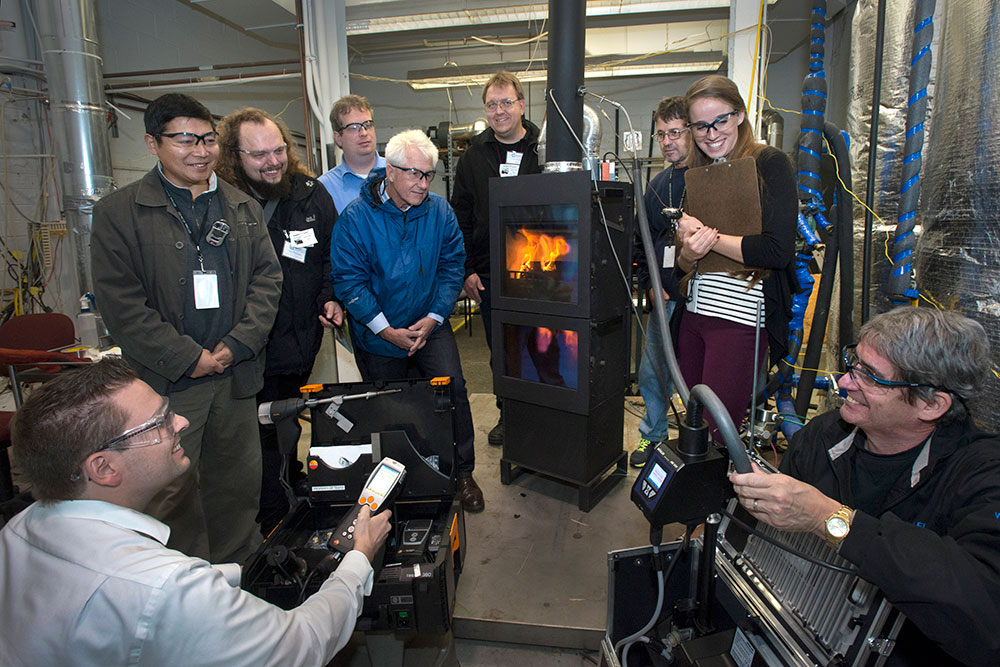National Labs, Alliance for Green Heat Announce New Push to Modernize the Wood Stove
December 20, 2021
 enlarge
enlarge
Brookhaven scientists and a team from Germany using a real-time particulate matter analyzer on a very clean wood stove design that employed gasification and combustion staging to achieve high efficiency and low emissions.
Dec. 16, 2021 — The U.S. Department of Energy’s Brookhaven National Laboratory and Lawrence Berkeley National Laboratory, along with the Alliance for Green Heat, announced today a renewed push to identify technologies for the next generation of wood stoves. Wood stoves are very effective at reducing the use of fossil heating fuels, but they are still manually operated, often leading to operator error and excessive emissions. This new initiative will bring together researchers, developers, and manufacturers to identify and demonstrate new pathways to consistently lower emissions.
The initiative is called the 5th Wood Stove Design Challenge, modeled after DOE’s Solar Decathlon. The first year of this Challenge features a series of seminars with domestic and international scholars, experts, and industry leaders. These groups will share knowledge on technical and cost barriers to achieving the levels of performance improvement needed to ensure wood stoves will contribute to the nation’s energy needs far into the future. The second year features a “technology slam” following the modified shark tank model, where judges will select teams to receive funding. During the third year, teams will build prototypes of next generation wood stoves and these will be tested under carefully controlled lab conditions.
“This competition will explore how far we can go in advancing residential biomass combustion. Wood stove technology does not need to be stuck in the past,” said Brookhaven Lab Engineer Rebecca Trojanowski.
The international competition is intended to show how modern technologies can help consumers use wood and pellets to meet renewable energy needs. Pellet stoves already represent a significant technology advance that consumers can adopt, and the technology is still improving. This challenge also seeks to bring many automated wood stove models to the market in coming years. The initiative supports the mandates of the national labs to bring scientific solutions to renewable energy challenges. It also supports the DOE goal of creating and sustaining American leadership in the transition to a global clean energy economy.
“The challenge provides a great opportunity for experts to collaborate and develop innovative technology solutions that help wood heating technology remain a mainstream renewable energy option,” said Berkeley Lab Research Scientist Vi Rapp.
Wood stoves remain a popular heating appliance in the United States, Europe, Russia, and many other regions. They offer flexibility as a primary or secondary home heater that can use free or low-cost fuel, functionality during electric outages or when off-grid, and energy efficiency savings by heating just the core of the home. The Energy Information Agency estimates there are 12.5 million homes in the United States that use wood or pellets for space heating. In about 2.5 million homes, wood stoves serve as primary heaters, and in about 9 million, they serve as secondary heaters, according to the US Census.
The 5th Wood Stove Design Challenge is funded by DOE’s Office of Energy Efficiency and Renewable Energy with support from the Osprey Foundation, and is managed by Brookhaven Lab, Berkeley Lab, and the Alliance for Green Heat, a Maryland based non-profit organization.
More details about the Challenge and upcoming workshops can be found at https://www.bnl.gov/woodheater/.
2021-19306 | INT/EXT | Newsroom









